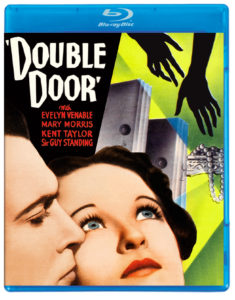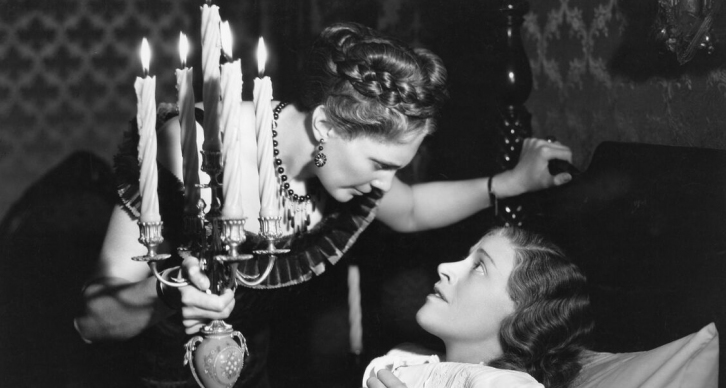Enter Into a World of One Rich Woman’s Domineering, Control, and Terror
DIRECTED BY CHARLES VIDOR/1934
BLU-RAY STREET DATE: JANUARY 4, 2022/KL STUDIO CLASSICS

Several years before Orson Welles went after media mogul William Randolph Hearst with Citizen Kane, the Wendel family- an affluent clan of New York real estate barons- became the target of 1934’s Double Door. Film historian Tom Weaver describes the real-life Wendels (led by the spinster sisters Ella and Rebecca) to have been “…as weird as they were rich…. And they were very rich!”
Before the film, Double Door was a 1933 Broadway play of the same title, written by Elizabeth A. McFadden. The on-screen depiction of the central family’s financial practices leaves no room for doubt as to the intentionality of the story. Domineering matriarch Victoria Van Brett, a starring role reprised from the stage by the great stage actress Mary Morris (in her only film role), decrees that none of the family’s property on the island of Manhattan will ever be sold. Nor will a penny be spent maintaining it. This was the Wendel’s standard operating procedure. Double Door adds exploitation of power, emotional abuse, and attempted murder to the mix.
Not quite the horror movie that some may consider it to be, 1934’s domestic chamber thriller Double Door is nonetheless something of a nail biter. Charles Vidor directs the film with a contained panache, with almost all action contained to the eerie Van Brett mansion- a Victorian shared space of winding railings, bric-á-brac, and a walk-in, and an airtight vault.
Perhaps it’s fitting that a movie entitled “Double Door” is outfitted with double audio commentaries. On the first, noted monster movie historian Tom Weaver plays it rather mischievously, inserting hokey sound effects to comment on the action, hurling puns, and even cutting away to arranged audio re-enactments of the play. Late in the track he even gives landmark-by-landmark walking directions to the New York offices of Kino Lorber. (A treat for any boutique label stalkers who make it that far into the commentary?) Most of his track, however, reflects his impressively in-depth research. At one point, he muses that he’s making a point of being as thorough as he can, because “God only knows if anyone will ever research this film ever again”. An entirely fair assumption, considering the previous scarcity of Double Door. Yet, presumably unbeknownst to Weaver at the time, Kino Lorber has somehow ended up with two commentary tracks for this release.

The second commentary is a two-person effort, with film historian David Del Valle and film historian/archivist Stan Shaffer. Both tracks are very good, with different variations in approach that are notable enough. If there’s commonality between this track and Weaver’s, it’s that everyone involved identifies as “monster kids”, having grown up enamored with golden age and silver age horror movies, and the Forry Ackerman magazines that obsessed over them.
Perhaps it was in these periodicals that these guys learned of the elusive Double Door, the marketing of which branded Morris’s insidious Victoria Van Brett as “The Female Frankenstein of Fifth Avenue!”. While she is in fact an incredibly monstrous, unpleasant, decrepit old woman (certainly in the running for the title of “Meanest Woman Ever On Screen”), things stop short of the supernatural. Everything that Van Brett does, from ignoring a lavish family wedding going on downstairs to withholding precious promised pearls from the bride (a radiant Evelyn Venable, also a veteran of the stage production) to calling the honeymooning couple back home over drummed-up financial matters (which place them on the losing end), is rooted firmly in real world greed and manipulation. It’s truly a shame that Morris (shockingly only in her late thirties at the time of production) never appeared in any other films, as her skulking, domineering presence is a truly twisted treat to behold.
So too is Double Door, now available as a rich-looking Blu-ray from Kino Lorber Studio Classics. At a brisk seventy-five minutes, there’s always time to enter into this tense but rewarding upper crust family drama. Just don’t get locked in!


